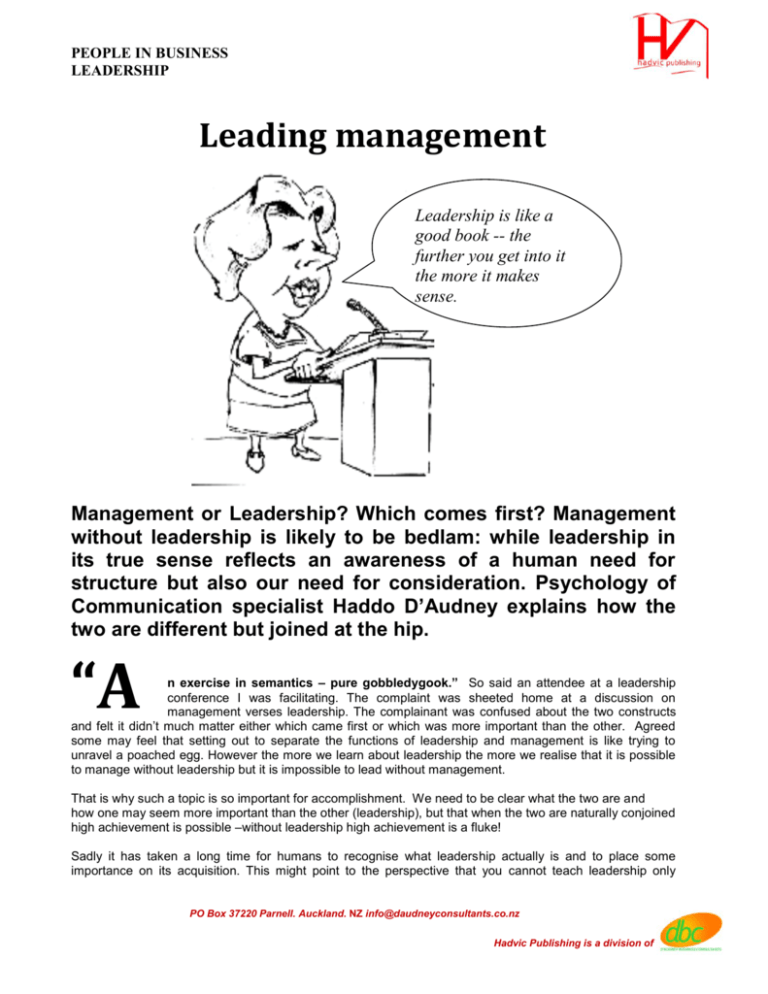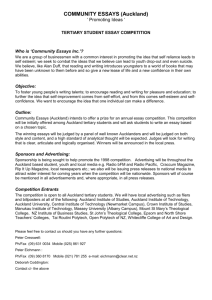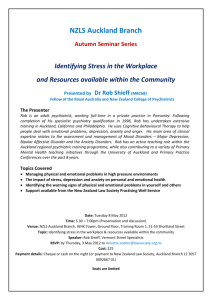Leadership versus management
advertisement

PEOPLE IN BUSINESS LEADERSHIP Leading management Leadership is like a good book -- the further you get into it the more it makes sense. Management or Leadership? Which comes first? Management without leadership is likely to be bedlam: while leadership in its true sense reflects an awareness of a human need for structure but also our need for consideration. Psychology of Communication specialist Haddo D’Audney explains how the two are different but joined at the hip. “A n exercise in semantics – pure gobbledygook.” So said an attendee at a leadership conference I was facilitating. The complaint was sheeted home at a discussion on management verses leadership. The complainant was confused about the two constructs and felt it didn’t much matter either which came first or which was more important than the other. Agreed some may feel that setting out to separate the functions of leadership and management is like trying to unravel a poached egg. However the more we learn about leadership the more we realise that it is possible to manage without leadership but it is impossible to lead without management. That is why such a topic is so important for accomplishment. We need to be clear what the two are and how one may seem more important than the other (leadership), but that when the two are naturally conjoined high achievement is possible –without leadership high achievement is a fluke! Sadly it has taken a long time for humans to recognise what leadership actually is and to place some importance on its acquisition. This might point to the perspective that you cannot teach leadership only PO Box 37220 Parnell. Auckland. NZ info@daudneyconsultants.co.nz Hadvic Publishing is a division of PEOPLE IN BUSINESS LEADERSHIP management. There is an element of truth in that –you learn management but maybe you (l)earn leadership: the classroom for management but the coal face for leadership. Combine the two and you have a state where a would be leader can avoid having to reinvent the wheel. We now know a lot about leadership secrets. Share them and we increase our stock of leaders before they give up trying to earn their spurs because it is so hard (uneasy is the head that wears the crown). By studying leadership we give young leaders the very thing they give others by definition –namely support. However it is still a battle to get the topic studied. Most learning institutions feel that the people side of organisational life is about soft skills and the technical stuff is the hard skill. One reason leadership is not given its true regard is that in reality it is the hard skill not the soft skill. Anybody with IQ (intelligence quotient) can learn calculus, project management even statistical analysis but can everybody learn leadership – my research suggests yes but it depends on context and desire and not so much IQ but EQ (emotional quotient). This neglect has a long history. Early researchers into effective organisations (Douglas McGregor, Abraham Maslow, Marry Parker Follett) were often pilloried as their people orientated findings began to filter through. At Harvard University such researchers were known as the Happiness boys and soft headed because “business wasn’t about making people happy.” They missed the point of course –we now know that work satisfied people produce more. Yet without leadership and management much of the learning is denied application—that is not to knock research for the sake of research or learning for the sake of learning but some learning has to be applied otherwise we are doomed to repeat the mistakes of history – ”Oops”’ I hear you cry, “We actually do that very well.” True, in reality those who don’t learn from history are doomed to spend their time repeating it. One thing we can learn from history is that a lack of leadership and management skill has been costly for the human race – and will continue to be so if we don’t apply some of that learning. Leadership and management are conjoined. They are like a truck and trailer unit. The question is which comes first? Management without leadership is likely to be bedlam: while leadership in its true sense reflects an awareness of a human need for structure but also our need for consideration. Thus leadership comes first. A leader knows how to manage but not all managers show leadership. What is management? What is leadership? There is only one thing stronger than my passion for leadership –GARLIC. You may have gained some ideas on both previously. However what is management? Most would assume that they knew the meaning of the word manage. However when asked for specifics the task is somewhat harder. The dictionary definition is not much help: to be in charge, to administer, to succeed in being able to do something, to contrive, to have room for something, to exercise control or domination over. Management itself is defined as the members of an executive or administration of an organisation or business; managers or employers collectively; the technique, practice or science of managing or controlling; the skilful or resourceful use of materials, time etc. A manager is someone who directs or manages an organisation, industry etc. “Leadership is the art of achieving more than the science of management says is possible.” PO Box 37220 Parnell. Auckland. NZ info@daudneyconsultants.co.nz Hadvic Publishing is a division of PEOPLE IN BUSINESS LEADERSHIP Managing is not the same as commanding. In fact an analysis of command gives a clue as to what goes wrong in the modern world with managers whose heads are in by-gone eras? Commanding is defined as “the authority vested in an individual over subordinates.” Historically of course this was exactly the model of organisational control. An older leader the author interviewed for a book on the topic told him that he well remembered being told by his supervisor. “I don’t manage you boy. I command!” The word management seems to have evolved, from Norman-French long before large scale commerce existed and it referred purely to the government of armies and naval fleets. One of the first uses of the word was in 1645 when the Commander of the Royal Army in Scotland (The First Marquis of Montrose) after seven successive victories against odds said: “Gentlemen—leave the issues to God and the management to me.” Management came from the military. Many management ideas and technique of course had their origins in the armed forces who, with churches, were the only larger-scale enterprises in existence. Historically military management methods were gratefully taken aboard by new evolving commercial organisations. They no doubt worked well against the historical fabric of a century or so ago. My A simple way to look at the complications of Management. Think of the human brain – few managers survive without having one or using one. For our purpose there are two brains at work within our craniums (we could argue there are three if we include the cerebellum at back of the neck). For all intent and purpose the brain has two main facets; lineal, which looks after the more analytical processes of life, and lateral which looks after more of the emotional and thus creative side. The brain (or management for that matter) is not actually this simple –if it was we wouldn’t be able to understand ourselves anyway. But for our purposes this brain model works fine. Managers tend to be good at planning, budgeting, processing, organising, calculating and implementing--all lineal activities. In the first instance leadership is more the lateral brain – although as we shall learn later leaders tend to be whole brained. They know when to go to logical or go emotional (we call this ability Emotional Intelligence). Melding the two? managers are all fair They treat us all the same –LIKE DOGS! In 1900, when these ideas were at their peak, only two percent of the world's population could read or write. Today with over eighty-four percent of the world’s population able to read and write, the command model does not have the same appeal under most microscopes – we want to be involved. Today the battle in organisational life is to shift away from the traditional model: move from authoritarian control to collaborative governance. “Managers manage things: leaders manage people.” Which comes first? Although some would suggest that Leadership is just one of the tasks for managers, nothing could be further from the truth. Many can manage but few can lead. It is perfectly possible to be a manager without being a leader; but to be a leader without managing is to deny the meaning of the word. Simply put leaders do manage, that is why they are leaders. PO Box 37220 Parnell. Auckland. NZ info@daudneyconsultants.co.nz Hadvic Publishing is a division of PEOPLE IN BUSINESS LEADERSHIP If they are not managing we could argue that this is because they are mere managers. Their focus is on structure, systems and things rather than people. Leaders lead people. Managers manage things –unfortunately those things include people. Our definition of leadership is: someone who is aware of their people’s needs for consideration but also of their need for structure. So which comes first and does it matter? It does matter, as you will see. Managers are those people who do things right. Leaders on the other hand are people who do the right things right, right? It is the battle between efficiency and effectiveness. Ants for example are really industrious critters –they buzz about the place keeping busy and being very efficient in what they are doing. But leaders realise that it is not enough just to be industrious. It is not enough to just be busy. The difference between them and managers is that leaders know it is perfectly possible to be very good at what you do. You can even do it right. But all that is for naught if you are not doing the right thing. Effectiveness is? The ‘e’ word is about ‘proactivity’ not just ‘activity’ or ‘reactivity’ for that matter. Leaders know that often the best thing to be doing is recognising, appreciating, rewarding, communicating, motivating, and advancing their people. Managers can be very good at planning, organising, controlling, budgeting, implementing and analysing but that at the time may not be what the context requires. Leaders are about vision, motivation, Leadership is like being in a dog sled team: if you are not the lead dog; your view doesn’t change much!” inspiration, teams, emotional intelligence, personalities, intuition, communication, amongst other things. Studies within a large global food and drink company, by the legendary psychologist David McClelland in 1996 showed for example the following. The divisions run by leaders with emotional intelligence capacities, outperformed yearly earning goals by 20%. Those run by managers showing managerial skills, yet lacking emotional intelligence capacities, under-performed by the same percentage. Without the more emotional side of leadership, a person may be competent at management, but they will never achieve great leadership. Leadership is thus about emotion. It is not a logical relationship a leader has with their followers. It may be logical if looked at later. But leadership is more lateral brain and management is more lineal brain. We have thus answered the question, which comes first? Decidedly leadership; then management follows. Both are necessary and can co-exist in the same person. Once leadership has captured the hearts and heads of their followers then it is time to put structure in place to reinforce the management process. So many managers are not leaders. But no leaders are not managers otherwise they cease to be leader. Leaders may not provide management but they know where to get good ones and they train people in both skills. Australasia in particular needs more leaders. We have enough managers. We need leaders to drive the export earning push. We need leaders to excite our passions to follow them to develop standards of living and keep talented people in our countries. We need leaders so we can achieve goals. We need leaders so we can have fun. The major role of leadership? That is why the major role of leaders is not to create more followers but more leaders. It is possible to analyse an organisation along two continuums: the need for structure and the need for consideration. A manager-need, first up, is structure: while a leader being self-aware would work with both, according to the needs of their organisation-- but their first priority would be their people. That’s the profound difference between the two disciplines PO Box 37220 Parnell. Auckland. NZ info@daudneyconsultants.co.nz Hadvic Publishing is a division of PEOPLE IN BUSINESS LEADERSHIP On deciding to lead On a personal level there are four areas of competency: 1. Lead yourself. You’ll never lead others until you can lead yourself. Walk the talk. 2. Lead others. If you show leadership characteristics you will attract followers then you have a responsibility to treat them with honesty, equity, integrity and respect. The study of leadership itself becomes an imperative even if you are told that you are a natural –don’t reinvent the wheel of fortune: grab a spoke from others. 3. Manage your EI and IQ. Your IQ got you the job but your EQ will get you leadership. The major resource you have is thus yourself. 4. Manage the tasks. The management function: the work to be done. This is about optimizing and achieving results through others, with others, for others and by others. Conclusions One indispensable ingredient in modern teams is leadership. Leaders turn groups into teams by giving them common goals and respect for each member and their potential contribution to the team. They also give them the structured supportive environment where everybody can realise performance growth. Teams can be very competitive within the team. True leaders manage this emotion carefully. Research with all Black Rugby and other winning teams shows that those who win, focus on performance excellence and ‘team first’ psychology. The hugely successful Australian rugby coach Bob Dwyer says, “I don’t want people who want to win, I want people who want to prepare to win.” Leaders know that a focus on personal achievement rather than competitiveness is a more appropriate behaviour for self-supporting teams. This focus also leads to more cooperative, collaborative and collegial behaviours. These build team cultures—particularly that nebulous team spirit. Team spirit, that gives competitive advantage in the ‘market place’ but not at ‘our place.’ One of the best illustrations of this phenomenon at work: it features two of the greatest golfers who have played the game. Arnold Palmer was asked why he was losing to Jack Nicholas. His answer sums up what leaders know; said Arnold: “I go out to beat Jack and Jack goes out to play good golf!” “Good luck on your leadershipmanagement journey”. REFERENCES Barnes, J.A. ( 2005 ). John F. Kennedy on Leadership. The Lessons and Legacy of a President. AMACON. N.Y Branson, R. (1995).In Jackson,T.Virgin King. Inside Richard Branson’s Business Empire.HarperCollins Publishers. London. D’Audney, H.R. (2005). The People Skills of Leadership (3rd Edition). Hadvic Publishing. Auckland. Goleman, D. (1998). What makes a leader? Harvard Business Review.Nov-Dec. P. 94-102. Goleman,D. (1995). Interview with Kim Hill. National Radio. Nine To Noon Programme. Johansson, J. (2005). Two Titans. Muldoon, Lange and Leadership. Dunmore Publishing. Wellington. Klein, S. (2002). The most Evil Dictators in History. Michael O’Mara Books Ltd. London. Goodwin, D.K.(2005). The Political Genius of Abraham Lincoln. Simon and Shuster. Lipman-Blumen;J.& Leavitt, H.J.(1999).Hot Groups. Seeding them, feeding them and using them to ignite your organisation. Oxford University Press. New York. McGregor, D. (1960). The Human side of Enterprise. McGraw-Hill. New York. Muchinsky, Psychology Applied to Work. 4th Edition. Pacific Grove. Brooks/Cole Publishers. P.396. Myers, D. In Phillips, J. (1999). Douglas Myers. What I’ve learned in Business. Nahanni Publishing . Auckland. P.18-19. Sculley, J.(1987). Odyssey: Pepsi to Apple. Harper and Row. New York. P.159. Van Zon, M (2001). Employee Sabotage. A Question of Perception. Auckland University Masters’ Thesis. Walsh,T.(2006). In, On Career Crossbars. Management Women. April. P. 7. Yeatts,D.E. & Hyten,C. (1998). High performing self managed work teams. Sage. Thousand Oaks.California. www.indexmundi.com/world/demographics_profile. PO Box 37220 Parnell. Auckland. NZ info@daudneyconsultants.co.nz Hadvic Publishing is a division of






